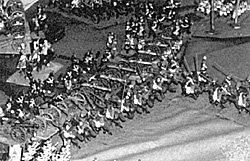 The first (fatal) manoeuvre of the day: the Don Cossacks attack the massed battery opposite Frischermont.
The first (fatal) manoeuvre of the day: the Don Cossacks attack the massed battery opposite Frischermont.
The Horse & Musket 'Bigbash' at Cancon this year was titled "La Grande Bataille" using the new Élan rule set. It was an outstanding success and proved to be one of the most spectacular events at Cancon 2000. Two 25mm armies of about 6 corps each - a total of about 3,500 figures on the table - and over a dozen players ensured a mighty struggle. The armies consisted of some very non-historical forces including Austrians, Russians, Danes and Bavarians to name but a few and the scenario was based on Waterloo or 'Liepzigerloo' as one wit put it. The Allies consisted of the 1st Corps under Matt 'Gniesenau' Corrin (1st Austrian & 2nd Prussian divisions), the 2nd Corps under Scott 'Viscount Trailape' Driscoll (4th & 5th British divisions), 3rd Corps - Ken 'Picton' Lee (5th British division), 4th Corps - Simon Hughes (cmdr) and Peter Braham (7th & 8th British divisions), 5th Corps - Mark Newman (9th British Division), 6th Corps - John 'Kutusov' Colwell (10th & 11th Russian divisions) and the Reserve (Austrian 3rd Division) under the Allied CinC 'Erherzog Schwanzeberg'
Der Miesterplan
The battle the Allies, the plan was essentially a defensive one. Assigning the British (2nd, 3rd & 4th Corps) the classic central position from Frischermont-Papelotte on the left to Merbe Braine on the right, I kept the Austrian 3rd Div as reserve directly behind the centre. I knew the French would make a flank march and guessed it would come on the other side of the Bois de Paris. I planned to have the Russians come on in a flank march of their own in a spoiling manoeuvre. As the final 'ace-up-the-sleave' I planned a 2nd flank march of my own with my Austro-Prussian 1st Corps - the most powerful in the Allied army - on the right flank, to come in on Turn 5 across the open area to the right of La Belle Alliance. The idea was that once the French were committed in their inevitable assault on the Allied centre, another powerful force would appear on their flank and rear - much like the Prussians did historically, but from the other side. Alas, like all great battle plans, it do not survive contact with the enemy!
Flank march #1
The French flank march came down the road running past the Bois de Paris to Papelotte. Our plan had been to use the same road to attack the French flank - it came to nought as the French poured in more and more troops onto our flank. As this avalanche of steel moved toward the shallow river on our extreme left we realised that if we left our Russians off table until Turn 4 as planned the French would have turned our flank by sheer weight of numbers. After a short conference with our esteemed Umpire we started moving John Colwell's Russian Corps on in Turn 2.
First blood went to the French when John's brigade of Don Cossacks made a charge at the massed battery set up on a ridge opposite the Bois de Paris, where they had been loitering with intent! John showed a willingness to 'have a go' from the start and I recall saying something like "Great - just make sure you hit them on initial..." or words to that effect. They didn't, pulling up just short. The French responded with a cataclysmic blast at point-blank range and 10 of the 16 figure unit were vapourised! Players were to find out the hard way that close range artillery fire in Élan is devastating -- as in reality, with a giant shotgun going off at close range your chances of remaining unscathed are slim. In the very next move the French were to find out for themselves as two regiments of French lancers also pulled up just short of the Russian guns with equally devastating results - with both units shattered and one routing off completely.
In one of the two most remarkable actions of the day (the other being the charge of the French Grenadiers ŕ cheval - see reference to it in Ian's report) the Ekaterinskaya Cuirassiers covered themselves with glory in a furious charge. They destroyed one regiment of lancers, routed another then proceeded to ride down two battalions of infantry - all for the loss of one figure! But they had still not finished, after cutting their way right through the French army they reformed and charged again, destroying another battalion of infantry and finished the battle still intact, still behind the French lines and about ride down a French gun battery. Not a bad day's work!
The Frischermont Salient
The most vulnerable section of the Allied line was the salient formed by the village of Frischermont which was also one of the most difficult to defend being surrounded by flat open g round. The village sits on a little hill like a shag on a rock right next to the French position. Directly opposite was a low ridge on which the French set up one of their massed batteries.
The task of holding this exposed position was given to veteran gamer (but Élan novice) Mark Newman and his single division.
The French pounded Mark's units in the open causing enormous casualties - nearly a third of all Allied losses were just from his division. The French opposite under Marechal Adam Stone were soon under pressure from 'Napoleon' Turton to take the salient. Mark cunningly put his cav between the villages and, their flanks protected by buildings bristling with muskets, they drove off every desperate attack, both cavalry and infantry. For some inexplicable reason the French never turned their awesome battery opposite on the village! Trying not to mask his guns Adam drive repeated attacks from the left of the ridge across the front of the Bois De Paris wherein lurked John's Russians and Mark's Brits. They constantly sallied forth and disrupted every French attempt right up until the final moves of the game when the frustrated French set fire to the woods with their guns and spoiled their fun.
Mark's sterling defence of Frischermont was aided by Ken 'Picton' Lee and his famous 5th Division (also sneakily referred to in our OB as a 'Corp'!), later reinforced with the Austrian 3rd Division.The taking of Frischermont would have almost certainly led to the Allied position being turned on the left. Mark and Ken not only fought off every attempt to do so but in the final bounds of the game, actually went over onto the offensive themselves. Mark's long-suffering infantry charged the guns and finally silenced the deadly French battery while at the same time Austrian and British cavalry launched a series of devastating attacks that, had the game continued another Turn or two, might well have seen the Allies break through. John, Mark and Ken with 4 divisions between them saw the Lion's share of the action, completely outfought their French counterparts and stopped half the French army in its tracks!
In the Centre
The centre of the Allied position (between Papelotte and Hougomont) was occupied by Ken Lee on the immediate left of the villages and Scott Driscoll (2nd Corps) with two divisions including the KGL occupying La Haye Sainte. He marshalled his artillery into a massed battery, reinforcing it with Simon Hughes 4th Corps artillery and both Simon and Ken's rocket troops. The Allies began a vigorous bombardment of the ridge opposite, inflicting serious losses on French and Danish massing there for the final attack. I must say that the bombardment rules are quite brilliant and Élan is the only rule set that I'm aware of that comes close to actually to reproducing on the tabletop what happened historically.
Scott Driscoll, an artilleryman in real life too, was definitely in his element pounding the French with his massed guns! By Turn 4 the French showed themselves sufficiently for Scott to throw forward his rifles and light infantry in skirmish and begin a vigorous harassing fire that lashed the French ranks. French artillery was also numerous (they managed three massed batteries to our one) and accurate as Scott lost two of his brigade commanders in the first round of firing! Their counter-battery fire eventually silenced some of our guns and the rocket troop but they also paid a heavy price for doing so, with no batteries remaining 'massed' by the end of the game!
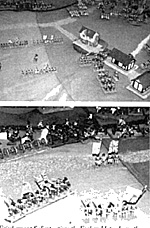 Top: The decidedly unhealthy open ground (directly in front of the guns) between the Bois De Paris & Frischermont.
Top: The decidedly unhealthy open ground (directly in front of the guns) between the Bois De Paris & Frischermont.
Bottom: Frischermont Salient action: the Forlorn Hope charge the guns - amazingly they succeeded - note the depleted guncrews.
Flank March #2
On the right Simon Hughes and Peter Braham, occupying Hougomont, sat and waited for the French attack that never materialised. Young Peter champed at the bit to get into action but I erred on the side of caution, aware that the French had an enormous reserve of Imperial Guard and heavy cav still uncommitted. I did however order a reconnaissance with Peter's light cav just to make sure there was nothing on the horizon. Under the watchful eye of Umpire Jones and getting an assurance from that slippery Frenchman opposite that there really was nothing there on Turn 4 I ordered the defence of Hougomont abandoned and the assault on La Belle Alliance to commence immediately.
The biggest mistake on the day was putting my most powerful Corps on a protracted flank march. The Austrians and Prussians did not come on the table until Turn 6 by which time the French assault on the centre of the Allied line was well under way. They were simply too far away to have any decisive effect on the battle. In hindsight I should have kept at least one extra division in reserve behind the middle of the line. As it was the Prussian cavalry had a minor effect on the left flank of the French attack but the Austrians were caught in a 'traffic jam' on the extreme right and never got into action. Their presence elsewhere on the battlefield may well have been decisive.
The Final Attack
The main French assault actually reached our position on the ridge and had even begun to penetrate in a few places but I didn't think the Allied line seriously threatened let alone beginning to 'crack'! Scott had carefully placed his troops on the reverse slope so that they were still virtually unscathed by the time the French approached the ridge.
I had also let Ken use the reserve Austrian 3rd Div to reinforce his joint operations with Mark at Frischermont and he cleverly held his cavalry (Austrian light cav brigade and British Heavies) until the right moment. His Brit cav smashed into the exposed flank of the French and Danish cav that had penetrated our gun line, also forcing several battalions of Bearskins into square directly in front of the guns! Ken still had an Austrian infantry brigade in reserve and Scott also had two brigades of infantr y and another of cavalry to meet the French even if they did manag e to break through our first line of defence on the ridge (but by the end of the game they still hadn't!).
Conclusion
By the end of the battle the Prussians were beginning to make their presence felt on the French left and another bound or two of play would have seen the French boxed in on three sides. The French attack on our left h a d failed completely, our centre was still firm with plenty of fresh troops available and the French were about to be about to be attacked by a fresh force twice their size on their vulnerable left flank. In spite of some late successes by the Guard cav (whose magnificent charges I think staved off an early collapse on their left), the Swiss holding La Belle Alliance vastly outnumbered, were under great pressure and I think it might have been the French who were about to 'crack'!
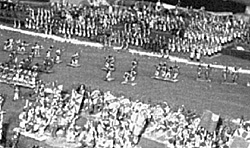 Scott & Ken's rifles and light inf harass the French & Danes amassed on the ridge opposite. Note the Allies massed battery with rocket troop (on the left) in the foreground.
Scott & Ken's rifles and light inf harass the French & Danes amassed on the ridge opposite. Note the Allies massed battery with rocket troop (on the left) in the foreground.
Doing a quick tally after the battle I estimated Allied losses at a little over 10% - and most of them from poor old Mark Newman's division (the survivors were still on the field of battle and - even more remarkably - victorious!) Just judging from the reduction in size of the host opposite the French and their allies, who did most of the attacking, must have lost twice that number. The only trouble with guessing what may have happened is that it's quite possible that the battle could have gone on for another 10 Turns - although I'd argue that if the French weren't defeated outright they'd have been conducting a fighting retreat! From a strategic viewpoint, the Brussels road, essential to any French plans for victory, remained firmly in Allied hands and indeed, was never seriously threatened during the battle.
Élan's Performance
Most of the problems encountered with Élan were minor ones but I share Ian's concerns with some aspects like the Class 6 (Guard) units, particularly cavalry, having almost superhuman capabilities. I also take issue with rockets but not with their erratic performance (that's historically valid); it's more to do with the result when they do strike a 'soft' target (i.e. horseflesh).
During the game one of Scott Driscoll's rockets hit a regiment of French cuirassiers as they stood in close formation, surrounded by other massed formations on the ridge opposite. The missile was deemed to have struck the centre of the formation and the result? - just 2 figures removed and the unit 'disordered' or 'shaken' for a Turn (and no effect on any adjacent unit).
I'm sorry Phillip but that's nonsense! We're talking about one of the loudest weapons of the Napoleonic Wars with a large warhead (for the time) that caused enormous destruction when it hit something. For even veteran cavalrymen to have regained control over their terrified mounts within one turn would be nothing short of miraculous! Equally miraculous would be the complete absence of effect on any adjacent unit. It's hard enough to hit anything with rockets so why not give a decent result for it when you do?
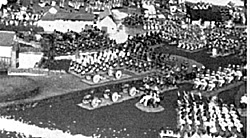 Austrians, Prussians (in foreground) and British stream towards French rear left at la Belle Alliance. Note the French assault against Allied centre above (top left).
Austrians, Prussians (in foreground) and British stream towards French rear left at la Belle Alliance. Note the French assault against Allied centre above (top left).
The only other bone of contention I have is that Élan still fails to give realistic performance modifiers that equate with serious casualties. The battle had plenty examples of units reduced to a few figures (in one case just the colour party!) and still going. Again, this simply doesn't accord with historic reality. The Prussian 'Kriegspiel' studies went into the combat effectiveness in relation to casualties with typical Prussian exactitude. They found that if a unit suffered more than about 1/3 casualties in a single action, that unit was effectively hors d' combat for the rest of the day (the formula is: 30% = kaput!) and interestingly they also found that this was equally true for all formations whether experienced or not.
While I don't advocate slavishly following this example on the tabletop (it'd make for some pretty quick and boring encounters!) I do think that a realistic sliding scale of performance be adopted for the effect of casualties on units in a single action. Ironically, for its vagueness in so many areas, WRG is still one of the few rule sets that does attempt to address this issue in some measure.
In fairness to Phillip - this is one of my hobby-horses we've talked about on a few occasions and I think we might have agreed to differ!
The above criticisms aside, overall the rules worked brilliantly and with a battle of this magnitude, if there were serious flaws you'd rightly expect them to emerge, particularly when you consider that only two of the players (Ian Turton and myself) had any experience of Élan. The fact that the battle flowed so smoothly with so little dispute is testament to what a great set of rules Phillip Jones has come up with.
Thanks must go to him for organising a terrific stoush and to my worthy opponent Ian 'French Bastard' Turton who never lost his Gallic bonhomie - even in the face of defeat! It was a great day's wargaming and thoroughly enjoyed by all. With a few minor amendments I think Élan will be a superb set of rules and personally I find it to be a breath of fresh air after the frustrating ambiguities of WRG!
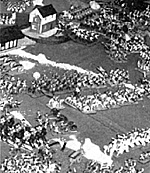 The final action: the view from Allied left centre towards Frischermont. From the top - John Colwell's Russians and Mark Newman's Brits go on to the attack with
an assault on the French and their German allies. Mark's Highlanders have already stormed the massed battery above Frischermont. Opposite the village Mark's light cav supported by Ken's Austrian cuirassier slam into the flank of the French cav. In the middle of the shot Ken Lee's Austrian Light cav brigade hit the advancing French Legere still in column
(ouch!) Below left & bottom right: Ken's Heavies charge the flank of the Danish cav as it penetrates the Allied gun line on the ridge. On the bottom left, the massed battalions of the Austrian reserve brigade await the outcome of the cavalry clash to their front.
The final action: the view from Allied left centre towards Frischermont. From the top - John Colwell's Russians and Mark Newman's Brits go on to the attack with
an assault on the French and their German allies. Mark's Highlanders have already stormed the massed battery above Frischermont. Opposite the village Mark's light cav supported by Ken's Austrian cuirassier slam into the flank of the French cav. In the middle of the shot Ken Lee's Austrian Light cav brigade hit the advancing French Legere still in column
(ouch!) Below left & bottom right: Ken's Heavies charge the flank of the Danish cav as it penetrates the Allied gun line on the ridge. On the bottom left, the massed battalions of the Austrian reserve brigade await the outcome of the cavalry clash to their front.
Für Kaiser und Vaterland - Gött Mit Uns!
--Schwanzeberg, Feldmarshal der Heer von Belge
More CanCon 2000 Convention Coverage
-
An Organizer Report
25mm Horse and Musket Results
DBR Renaissance Wargaming
ACC Report 22nd Australian Ancients Championships
Waterloo
Elan La Grande Bataille
Elan Waterloo
H&M Big Bash
Brisbane BIG
Back to Table of Contents -- Kriegspieler #8
To Kriegspieler List of Issues
To MagWeb Master Magazine List
© Copyright 1999 by Kriegspieler Publications.
This article appears in MagWeb (Magazine Web) on the Internet World Wide Web.
Other military history articles and gaming articles are available at http://www.magweb.com